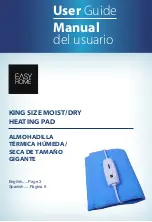
9.
Attach the access panel using screws and self locking nuts at the hinge brackets. Tighten sufficiently
so that the panel is capable of opening smoothly and evenly.
Clamp the access panel to the side panel and rock the structure to ensure it is stable and that no
particular component is unduly stressed. When satisfied, gently unfasten the access panel and
tighten all nuts, top and bottom.
5
10. Lower the complete sub-assembly to the floor.
11. Remove the three M8 screws with nuts from the end plate of the stack, (Fig.3), and
the three M6 screws from the oppposite end. Locate the stack over the holes in
the top of the conical cover, and secure with the M8 nuts and screws.
12. Before mounting the burner head on to the stack, remove a nut and a flat washer,
from each of the studs on the crown of the burner unit, leaving a flat washer on
each stud, then lower the burner assembly on to the stack, threading the the hose
(8) with gas regulator (19), down through the stacks’ centre.
13. Line up the holes in the rim of the burner unit tube with those in the stack , and
insert the three M6 screws, previously removed. Tighten securely.
14. Standing on a step ladder or similar, mount the hood on the studs. Replace the flat
washers followed by the nuts and tighten securely.
CAUTION: In the case of replacement, it is important that the screws, washers and nuts fastening
the hood (1) and the screws fastening the radiating diffuser (9), are stainless steel.
CONNECTING THE GAS BOTTLE
1.
Unclip the access panel (21) and check condition of the regulator and hose.
2.
Screw the regulator into the outlet port on the cylinder and tighten securely.
3.
Check that the tap turns easily and that there are no gas leaks, using foam or soapy water...NEVER
use an open flame.
4.
Place the cylinder in its compartment and ensure the flexible hose is not stretched or kinked. Replace
the access panel
OPERATION
We recommend that first time starting be carried out in the open air, as fumes are given off due to the
elimination of the protective lubricants.
1.
Unclip the access panel and turn ON the gas by turning the tap anticlockwise fully...Secure the
access panel
Fig.3
2.
Turn the control knob (6) on the front of the stack fully clockwise to
the “START” position (Fig.4).
NOTE: push the knob inwards slightly in order to turn it.
3.
Press the control knob inwards fully for 40-50 seconds then press and
release the start button (5) several times until the pilot flame, viewed
through the window, in the conical protector (13), is lit.
4.
Once the pilot flame is lit, wait a further 10-20 seconds before releasing
the control knob.
5.
If the pilot light goes out, press the control knob once again and hold
in that position whilst repeatedly pressing the start button.
6.
When the pilot light remains ON, push the control knob inwards slightly
(
NOT FULLY
) and turn it anticlockwise to a suitable position between
Min
imum or
Max
imum (Fig.4), according to the capacity required. It
will take 3-5 minutes before the effects are felt.
Fig.4


























